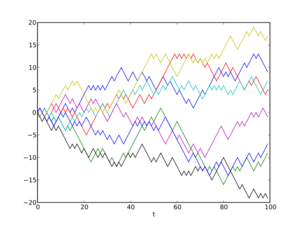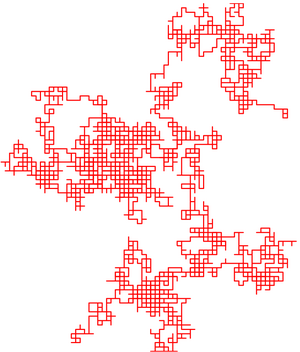Random walk facts for kids
A random walk happens when something moves by taking steps in random directions. Imagine a tiny bug walking on a floor, but instead of going in a straight line, it picks a new random direction for each step. That's a random walk!
Contents
What is a Random Walk?
A random walk is a mathematical idea that describes a path made of a series of random steps. Think of it like flipping a coin to decide if you take a step forward or backward. If you do this many times, you're performing a random walk.
Simple Examples of Random Walks
- Coin Flip Game: Imagine you're playing a game where you start at zero. If a coin lands on heads, you add 1 to your score. If it lands on tails, you subtract 1. Each flip is a random step, and your score over time is a random walk.
- Drunkard's Walk: A classic example is a person who has had too much to drink. They might stumble a bit, taking steps in unpredictable directions. Their path would be a random walk.
- Ant on a Grid: An ant walking on a grid of squares, choosing randomly whether to move left, right, up, or down at each intersection, is also doing a random walk.
Where Do We See Random Walks?
Random walks might sound like a simple game, but they are super important in many areas of science and the real world!
In Nature and Science
- Molecules Moving: Tiny particles like pollen in water move in a jerky, random way called Brownian motion. This is very similar to a random walk. Scientists use random walks to understand how heat spreads or how smells travel through the air.
- Animal Movements: Sometimes, animals search for food or explore new areas using paths that can look like random walks.
- Genetics: Random walks can help scientists understand how genes change over time.
In Technology and Finance
- Computer Simulations: Game developers and scientists use random walks to create realistic movements for characters or to simulate how things spread, like a virus in a population.
- Stock Market: The prices of stocks in the market often seem to move randomly, going up and down without a clear pattern. Some people use random walk ideas to try and understand these movements, though it's very complex!
- Internet Search: Believe it or not, the way search engines like Google rank websites can involve ideas from random walks, as they "walk" through links on the internet.
Images for kids
-
Antony Gormley's Quantum Cloud sculpture in London. Its design was created by a computer using a random walk idea.
See also
 In Spanish: Camino aleatorio para niños
In Spanish: Camino aleatorio para niños

All content from Kiddle encyclopedia articles (including the article images and facts) can be freely used under Attribution-ShareAlike license, unless stated otherwise. Cite this article:
Random walk Facts for Kids. Kiddle Encyclopedia.







